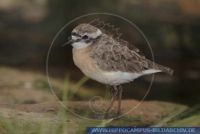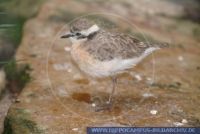Charadrius pecuarius
Kittlitz’s Plover
Exif Keywords:
Exif ImageDescription:
The Kittlitz’s Plover, Charadrius pecuarius, is a small plover found in much of sub-Saharan Africa, Madagascar, and the Nile delta. Some birds, especially in coastal areas, are resident, other populations are migratory or nomadic.The adult Kittlitz’s Plover is 14–16 cm long. In breeding plumage it has a grey-brown back, crown and wings, an orange breast shading to white on the lower belly, and long dark grey legs. The forehead and throat are white, with black lores and a black frontal bar, the latter extending as a stripe down the sides of the neck and around the hind neck. In winter, the adults lose the distinctive face pattern and resemble Kentish Plovers, but they are smaller, longer-legged and longer-billed. They have less uniform upperparts than Kentish, and always show a pink or orange breast colouration. Juvenile Kittlitz’s Plovers are similar to winter adults, but the underpart colour is often restricted to just a narrow gorget. In flight, the primary flight feathers are dark with a short white wing bar. The Kittlitz’s Plover forages for food on open dry mud and short grass, usually close to water. The specific name, pecuarius, means "grazer", referring to the grassland habitat. It hunts usually by sight for invertebrates including insects, earthworms, crustaceans and molluscs. The call is a plaintive tee peep, and this plover may give a hard trip when alarmed....Its breeding habitat is open ground on beaches or dry mudflats, near water and with little or no plant growth. The nest is a simple scrape, and both parents incubate the usually two eggs. If a potential predator approaches the nest, the adult will walk away from the scrape, calling to attract the intruder and feigning a broken wing. Of course, once the intruder is far enough from the nest, the plover flies off. Kittlitz’s Plover is gregarious outside the breeding season, feeding and roosting in mostly small groups, but in flocks of up to 250 on migration.Source:Wikipedia
Viewed 5461 times







